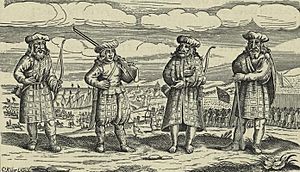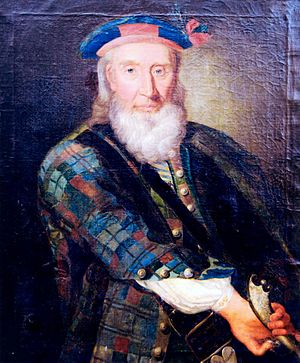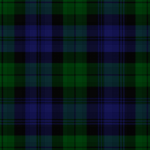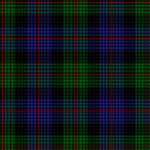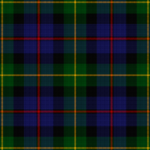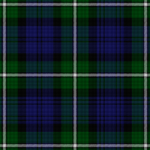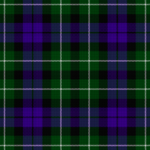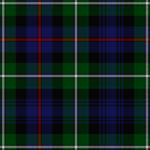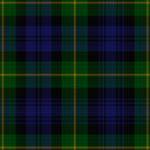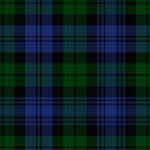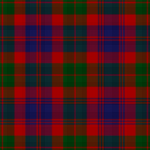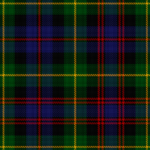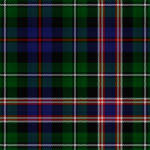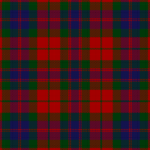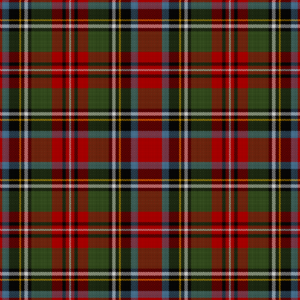Regimental tartan facts for kids
Regimental tartans are special tartan patterns used for military uniforms. These patterns were first worn by some Scottish clan groups who acted as local armies. Later, they were used by the Independent Highland Companies (IHCs) set up by the British government. Then, many Highland regiments and Lowland regiments of the British Army started using them. Eventually, military groups in other countries also adopted them.
The first hints of uniform tartans for these groups appeared around 1691. The very first clear uniform tartan was for the Royal Company of Archers in 1713. The IHCs, formed between 1725 and 1729, likely had one or more uniform tartans.
The first real Highland regiment in the British Army was the 42nd Regiment of Foot, also known as the Black Watch. It was formed in 1739. This regiment had its own special uniform tartan by 1749 or 1757 at the latest. This tartan is now famous as the Black Watch, 42nd, or Government tartan. Some later Highland units also wore this tartan. Others made small changes to it, often by adding bright thin lines called "over-checks."
A few regiments created their own unique tartans that were not based on the Black Watch pattern. These included the 75th and 79th Regiments, the Fraser Fencibles, and the Loyal Clan Donnachie Volunteers. Some units even designed special tartans for their musicians and elite soldiers.
Regimental tartans helped lead to the creation of clan tartans in the late 1700s and mid-1800s. After clan tartans became popular, many regiments started using clan tartans in their uniforms. Since 2006, most Scottish regiments joined to form the Royal Regiment of Scotland. Now, only about 10 tartans are used for British military units.
Contents
Early Military Use of Tartan
For a long time, Scottish clans had their own local armies, called militias. They used these groups to fight each other. Starting in 1603, the British government began to create its own special militia units in the Highlands. These were called the Independent Highland Companies. Their job was to keep peace in the area and help with things like building roads.
In 1627, a man named Alexander MacNaughtan put together a group of Highland archers. They wore tartan and served under the Earl of Morton for King Charles I of England. The earliest picture of Scottish soldiers in tartan is from 1631. It shows Highland soldiers from the Thirty Years' War landing in a port. These soldiers were likely "Mackay's Regiment." The picture shows them in different tartan clothes, but it's hard to tell if it was a uniform.
More independent companies were formed by the government in 1667. We don't have much information about the tartans they wore.
In 1691, a poem described Highland troops at the Battle of Killiecrankie. It said they could be told apart by the colors of their socks, coats, and tartans. While the poem didn't use terms like "regimental tartan," it seemed to describe uniforms. Some historians believe it was cheaper to make a lot of the same cloth. Also, commanders were proud to have their soldiers in matching uniforms. However, a 1709 report said that independent companies wore clothes just like regular people. This helped them spy on anyone planning against the government.
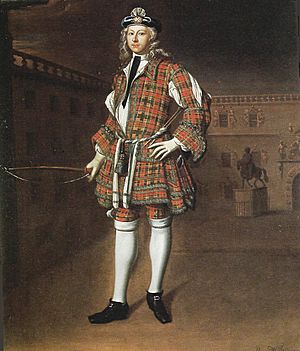
In 1713, the Royal Company of Archers became the first group serving the British crown to use tartan as part of their official uniform. This group started as a private archery club in 1676. Later, it became a ceremonial group that served as royal bodyguards. Their first red tartan was used for a dress-like tunic and matching short trousers called trews. This tartan was very complex. Paintings from that time don't quite match the real uniform. But, from a few uniforms that still exist, we know what it looked like. This pattern might have influenced later clan tartans. In 1789, the company switched to the Black Watch tartan. They stopped using tartan around 1860–70.
In 1703 and 1704, the chief of Clan Grant ordered his 600 "fencible" men to get coats, trews, and socks of red and green tartan. Some writers thought this just meant green and red colors, not a specific pattern. But, there is some evidence that by 1715, the Grant militia wore a consistent tartan. One old paper said Brigadier Grant's men were "well armed and clothed, in one livery of tartan."
The Independent Highland Companies were formed again between 1725 and 1729. These groups were made up of clans loyal to the British government. Many young men from important families joined them. It seems that at least some of these groups wore uniform tartans. This helped them avoid being linked to just one place or clan. One of their main jobs was to take away weapons from clansmen, following the Disarming Act 1715.
The tartans might have been slightly different among units at first. But they were all blue, black, and green. They probably had different thin lines (over-checks) to tell them apart. By 1733, all units were using the same tartan. A 1725 order from Major-General George Wade said that officers should make sure their soldiers had "Plaid Cloathing & Bonnet in the Highland Dress." It also said the plaid should be "as near as they can of the same sort & Colour." Later, in 1733, it was confirmed that all units used the same tartan cloth.
A portrait from around 1769 shows an elderly Robert Grant of Lurg. Some people believe he is wearing the military uniform from his youth. This portrait might show the tartan of the independent companies. There are four versions of this painting. Three of them show a tartan similar to Black Watch, but with a wide reddish-brown band.
More loyal independent companies were formed in 1745 to fight against rebel clans during the Jacobite rising of 1745. They continued until 1747. These groups did not wear a uniform tartan. However, they did wear a uniform badge: a black Hanoverian cockade with a red or yellow cross on their hat.
Between 1739 and 1815, over 100 military groups were formed in the Highlands. Many of them wore Highland dress. But only some had distinct uniform tartans. And only a few of those tartans are still known today.
First Highland Regiments
The first Independent Highland Companies were combined in 1739. They became the Earl of Crawford's Highland Regiment, which was the 42nd Regiment of Foot (later called the 42nd). This regiment was unofficially known as the Black Watch. This name became official in 1881. It was the first proper Highland regiment in the British Army. For formal dress, they wore the belted plaid (a large kilt). For everyday uniform, they wore the tailored small kilt (since at least 1759).
For the belted plaid, they used a special tartan. It was first called the "42nd tartan." So, it probably wasn't adopted until the unit was renumbered the 42nd in 1749. It might have been created as late as 1757. This tartan was likely based on the ones used by earlier independent units. But it had double black lines, called "tram lines," added. A simple drawing from 1742 shows the 42nd's belted plaid worn in a strange way. The tartan was set diagonally, making diamonds instead of squares. Another drawing from 1742 shows the same. But a third picture from around 1743 shows it worn with stripes horizontal and vertical.
The Black Watch pattern was used by many other regiments. It's thought that to dress all these soldiers, about 30 to 40 miles of this tartan had to be woven before 1750 alone. It became the basis for many later regimental and clan tartans. Today, it's still popular for everyone to wear. It's known as "Black Watch," "Government," and other names. The military officially calls it "Government No. 1."
The exact pattern of the 42nd Regiment's original small-kilt tartan isn't fully clear. But it's thought to have had a red over-check added over the blue, green, or both. It's sometimes called "the Atholl sett." The best example of it appears in a record from Wilsons of Bannockburn in 1785. It was used for the 42nd's small kilts until the belted plaid was stopped around 1814. After that, the unit used their regular Black Watch tartan for the small kilt. Elite soldiers called Grenadiers also used this red-striped version in their belted plaid.
Loudoun's Highlanders (the 64th regiment) were formed in 1745. They used a tartan with blue and green checks. It had thick black borders around the blue, like Black Watch. It also had red lines (on blue) and yellow lines (on green). It didn't have the two black "tram lines" of Black Watch. This general color scheme of blue, green, and black seemed to be ordered for all regiments. Lord Loudoun tried hard to get a red tartan for his men, but he never succeeded.
New regiments were formed for the Seven Years' War (1756–1763). Little is known about what they wore. The Queen's Own Royal Regiment of Highlanders (105th Regiment of Foot) was formed in 1760. A portrait of their commander, William Gordon, shows him in a uniform with an unusual tartan. It looks more striped than checked. But there's no proof that this specific tartan was part of the uniform.
Tartan Changes in the Late 1700s
Other Highland regiments were formed later to serve in places like India and America. They also fought in the Napoleonic Wars. For many Scottish landowners, forming a regiment for the king was a way to show loyalty after the Jacobite uprisings. It helped them gain royal favor and even get back land they had lost. These soldiers were allowed to wear Highland dress, even though the Dress Act 1746 had banned it in the Scottish Highlands. This made Highland dress a symbol of Scottish pride within the British Empire.
Around 1765, a weaver named William Wilson & Son of Bannockburn (Wilsons) started making tartan. By 1770 and throughout the 1800s, they had a near-monopoly on weaving tartan for the regiments. They also became very important in tartan weaving in general. They made different qualities of regimental cloth for officers, sergeants, and regular soldiers.
During this time, regiments often changed names or combined with other units. Regimental uniforms, including tartans, were often chosen by their commanders. The colonel's personal choice and reputation were important. This led to both stylish and practical choices. Around 1814, regiments stopped using the belted plaid and started using the smaller kilt.
Two regiments first used Black Watch tartan. Then, in 1787, they adopted a version with thin red (on blue) and white (on green) lines. These were MacLeod's Highlanders (71st Regiment) and the original Seaforth Highland Regiment (72nd). This pattern is also known as "Mackenzie–MacLeod" after the commanders. It later became the Clan Mackenzie tartan. It is still used as an official British military tartan, called "Government No. 5A." A small change, using yellow instead of white, became one of the Clan MacLeod tartans.
The 74th (Highland) Regiment of Foot, formed in 1787, used another Black Watch tartan. It had a white over-check with black borders on the green. Also in 1787, the 75th (Highland) Regiment probably used a more unique tartan. It was not based on Black Watch. It had purple and black on a green background, with thin white and even thinner black lines. It was later called "No. 64 or Abercromby" by Wilsons.
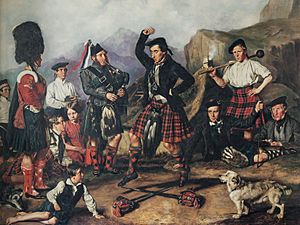
The Gordon Highlanders also wore a changed Black Watch tartan. This one had a thin yellow line (on green, with no black lines around the yellow). This pattern was designed in 1793. A kilt from this regiment still exists today. This pattern became the main tartan of Clan Gordon.
Also in 1793, the Cameronian Volunteers (79th Regiment) used a very different tartan. Later, around 1830, it became the family tartan of Cameron of Erracht. It looks a lot like Black Watch, but it doesn't have black lines. Instead, it has many yellow and red lines. It is similar to the MacDonald and main Cameron tartans. Some say it was designed by the unit leader's mother or grandmother.
The Fraser Fencibles were formed between 1794 and 1795. They used a tartan with a red background and green and blue bands. This was not related to the Black Watch style.
The Sutherland Highlanders (93rd), formed in 1799, might have worn a lighter version of Black Watch. It had lighter blue or Balmoral blue instead of the original dark blue. This tartan is also used as a Sutherland area tartan and as one of the Clan Sutherland patterns. It is still used militarily as "Government No. 1A."
Some regiments also created separate tartans for their pipers and drummers. These could be very different from the usual black-blue-green style. The band tartan of the 42nd was the Black Watch pattern, but with red instead of black. This tartan was used by the 42nd from at least 1780 until around 1865. It was also used by musicians of the 93rd for a time. Both units' musicians switched to Black Watch in 1865.
Wilsons sometimes used purple instead of blue for officers' tartan cloth. The exact shades of blue and green changed over time. By the late 1700s and early 1800s, women in Scotland wanted to dress in their husbands' uniform tartans. The Highland regiments became famous for being brave and effective. This helped keep interest in tartan and kilts alive, even though the Dress Act had banned them.
-
71st MacLeod's Highlanders, 72nd Seaforth Highland, and 78th Highlanders Ross-shire Buffs; became the clan tartan of Mackenzie, and used as "Government No. 5A."
-
79th Cameronian Volunteers, later Queen's Own Cameron Highlanders; now also the tartan of the Cameron of Erracht branch of Clan Cameron.
-
92nd Gordon Highlanders; became the main tartan of Clan Gordon; also used by 8th (Rothesay and Caithness) Fencibles.
-
Possible lighter version of Black Watch for 93rd Sutherland Highlanders, later Argyll & Sutherland Highlanders; also used as a Sutherland district and Clan Sutherland tartan; a version later became "Government No. 1A."
-
Loyal Clan Donnachie Volunteers; later the hunting tartan of Clan Robertson/
Donnachaidh/ Duncan.
How Regimental Tartans Influenced Clan Tartans
Tartan experts generally agree that regimental tartans and local "district" tartans led to the creation of clan tartans in the early 1800s. Some regimental tartans were directly adopted by clans. For example, the tartans of Cameron of Erracht, Gordon, Mackenzie, and Roberson/Donnachie/Duncan came from regiments. In some cases, more than one clan adopted the same regimental tartan. For instance, Black Watch is also known as old Campbell, hunting Grant, and hunting Munro. Many other clan tartans were based on Black Watch tartan with some added differences. These include Forbes, Lamont, hunting MacRae, and Urquhart.
Modern Use of Regimental Tartans
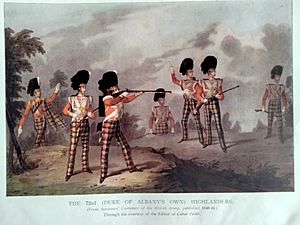
After the popularity of "clan tartanry" in the early to mid-1800s, many Highland regiments started using the new clan tartans for their uniforms. This was the opposite of how it started, where regiments influenced clan tartans. Some of these adopted clan tartans are still used in regiments today. These include tartans of clans like Douglas, Erskine (red), Leslie, Rose (hunting), Stewart (royal and hunting), and Sutherland.
Between 1823 and 1881, the 72nd Regiment, Duke of Albany's Own Highlanders wore tartan trews (trousers). They used a tartan called Prince Charles Edward Stuart. It is very similar to royal Stewart, but with less red. It used lighter blue and green colors in their uniforms, as shown in old paintings. This tartan is one of the oldest patterns still made today.
The Lowland regiments (which had been around since 1633) started wearing tartan trews in 1881. This connected them to the Highland regiments while still being different. Usually, they used the "Government" (Black Watch) tartan. But some units later chose other tartans. For example, the King's Own Scottish Borderers adopted Leslie tartan in 1881. The Cameronians (Scottish Rifles) used Douglas from 1891. Several Highland regiments were also given new tartans that were clan tartans, not just for their unit. For example, the Royal Scots adopted the hunting Stewart tartan in 1901.
There has been some confusion about tartans called "Universal," "Childers," and "Childers Universal." For a while, the War Office called Black Watch "Universal" after the Childers Reforms of 1881. The plan was to make all Scottish regiments wear it, but this idea was dropped after many complaints. A tartan called Childers was worn by some Gurkha Rifles units. It was dark green with red stripes. The Childers Universal pattern is different. It was designed in 1907 for an "important regiment of the Indian Army." It's a version of Mackintosh tartan, with a black background and two different green checks.
In total, there are at least 38 documented tartans that have been linked to regiments at some point. Many of these are also linked to clans.
Today, about 12 tartans are officially used by the remaining historical Scottish regiments. Most of these regiments have joined together since 2006 to form battalions within the Royal Regiment of Scotland. There are also some other patterns used by the British Army Reserves. These tartans are only worn for formal dress and by pipe bands. This is because practical uniform changes were made during World War II, which stopped the use of tartan kilts and trews for everyday uniforms. Some military units in other countries also have their own tartans.
In 2006, the British Ministry of Defence caused some debate. They allowed foreign companies to bid for contracts to make tartans for Scottish troops. They also lowered the high quality standards for the cloth. Some people worried that the quality and consistency would suffer.


